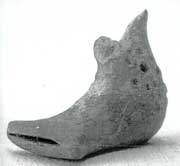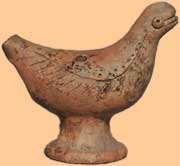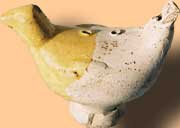|
|
E a r t h s o u n d s

Epalladio Art Workshop is in the reproduction business. We
resurrect for contemporary use some of the most eminently
practical (and some of the most delightfully frivolous)
items from the past. This season we join the long tradition
of whistle-makers with the introduction of our own line of
vessel flutes, ranging from simple whistles to ocarinas.
With respect to traditional shapes we have put our talent to
the test by creating animal and bird shapes, as well as the
more traditional sweet potato shaped instruments. When they
are finished it’s a great feeling to hear their ‘earthy’
tunes! What a concert in our studio as we test each one to
assure that it sounds sweet! We have had to look hard at the
history of the ocarina to come up with our designs. It is
not so simple a story. One need just imagine why early
humans wanted to reproduce the sound of the human voice
whistle, or the call of a bird, etc. Was it to facilitate
hunting? To identify an individual by his specific call? To
communicate? Or to have some entertainment once in awhile?
Whatever the reasons, it is agreed that the appearance of
the vessel flute spans dozens of centuries and any number of
regions throughout the world
Everybody had a whistle of some kind; whether it was
fashioned out of horn, gourd, clay, bone, jade, seaweed,
(and the list goes on,) was a matter of choice, and
convenience, of course.

Although the historical timeline is not entirely
certain, sources cite tangible finds of ceramic wind
instruments from at least 12,000 years ago. Native Americans
crafted zoomorphic and anthropomorphic fifes, whistles, and
ocarinas for centuries. Tribes in Honduras
personalized their whistles so that each individual could be
identified by his own sound. In
India
the pottery fipple flute was in common use 6000 years ago.
But it is the Chinese who, even earlier, had developed the
true vessel flute for use as a musical instrument. The
original Xun was an egg-shaped earthenware wind instrument
with six holes and an embouchure. Later the Xun was made in
fine porcelain and found its place as an essential
instrument in Chinese music. Chinese music, however, was not
easily understood by the European ear. It took a long time
and an unusual turn of events before the ocarina won respect
as a real concert instrument in
Europe.
In 1527 the
explorer Cortez brought a troupe of Aztec dancers and
musicians to Europe for the
pleasure of the Emperor Charles V. These Aztec musicians
staged an impressive performance playing their traditional
South American fipple pottery whistles and vessel flutes,
which were in all sorts of animal and bird shapes. The
people were taken by these sweet-sounding little
instruments. At the time it was convention for bakers to use
their ovens to make low-fire pottery items. It seems one
such Italian baker took to producing replicas in the shape
of little geese. This novelty toy was the first European
ocarina, which means “little goose” in Italian.

The ocarina remained a very popular toy, entertaining
children and adults alike throughout Europe for nearly 350 years. In the mid 19th
Century a young Italian musician-baker named Guiseppe
Donati, inspired by his own interest in music, started
experimenting with the ocarina until he developed a
prototype which could play a true pitched diatonic scale
accurately. The handmade Donati ceramic ocarinas, which
varied in size and number of holes, became immediately
popular for group and solo concert performances throughout
Europe. By 1878 there was a call for innovation
in production. Caesare Vicinelli, also a kilnman and
talented musician, developed a distinctive mould process for
the more rapid production of ceramic ocarinas. Since this
time, the ocarina has been crafted in many different
materials, including metals and plastics, in many different
parts of the world. The whistle has evolved, but maintains
its greatest attribute as a real “morale booster!”
Ocarinas have impressed and delighted music makers
for thousands of years. At whatever level you find
yourself---musician or sweet-noise maker---you can find an
ocarina to please among our collection.
Join the fun!
Click
to view each ocarina collection
|